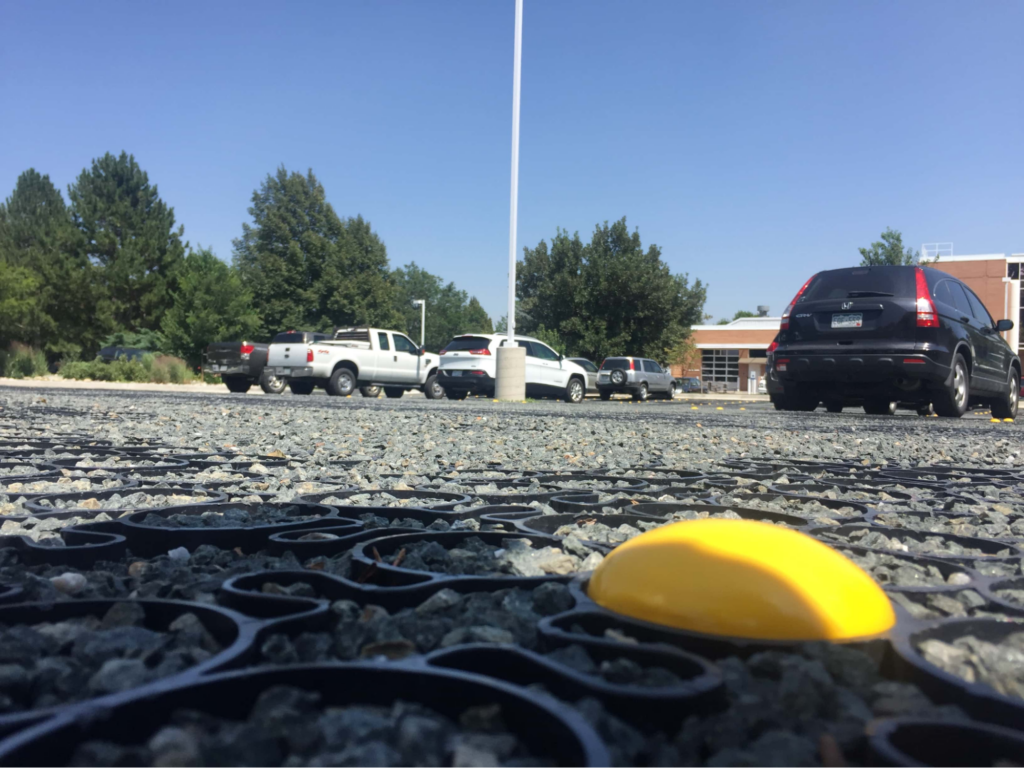
There are few worse ways to start your day than pulling into work in the morning and opening the car door only to find yourself surrounded by water from last night’s rain storm. You try to jump from your car to the lone visible dry spot, but you don’t make it, not even close. You now have to spend the rest of the day with cold, damp feet; happy Monday.
What causes concrete puddling after a storm? Why are there low spots? Why doesn’t the water drain? Could these puddles indicate some underlying problems with the parking lot structure? It turns out there might be more to puddles than you think.
Are Puddles in Your Parking Lot a Bad Thing?
The short answer is yes; puddles are not ideal.
Besides being a tremendous pain for you, your customers, patrons, tenants, or anyone else using your parking lot, standing water can cause damage, indicate subsurface problems, and be unsafe.
What Causes Puddles to Form in Parking Lots?

Aside from the obvious answer being rain, many things may be causing the concrete to puddle in your parking lot. From heavy traffic to poor drainage and improper installation, there are more possible causes for your puddling than you may realize.
Rutting
Rutting is more common on unimproved dirt roads, unplowed snowy roads, and poorly installed gravel, but it can also happen in asphalt.
Rutting can occur due to an improper mix of asphalt materials. The asphalt mixture can compress over time and heavy use to create disappointing ruts in your parking lot that pool water when it rains.
Rutting can also commonly occur due to pre-existing ruts in the subgrade.
The subgrade to a parking lot is layers of compacted gravel, crushed stone, and sometimes sand. The subgrade is what the asphalt layer of your parking lot is poured on top of.
Sometimes, when pre-existing ruts exist in the subgrade, the asphalt will settle, which affects the surface of the road or parking lot.
Raveling

Raveling is another result of an improper asphalt mixture.
Raveling happens when the bond between asphalt’s aggregates and polymers or binding agents is broken. The broken bond results in a loose gravel and sediment layer on top of your asphalt. The loss of top-layer aggregates in asphalt results in dimples and divots where water can accumulate. This thin pooling of water on top of your asphalt and the layer of loose gravel and sand can create a potential hazard for loss of traction and hydroplaning.
Heavy Vehicle Traffic
Unfortunately, even correctly mixed and installed asphalt will break down and wear over time. Consistent vehicle traffic, especially if your parking lot is frequented by heavier vehicles like trucks, RVs, or commercial construction equipment, can significantly affect your parking lot over time.
Poor Drainage
A common culprit in forming parking lot puddles, poor drainage is often to blame for concrete puddling.
Although most parking lots should be built with a slight pitch to avoid standing water, it is often not enough. Many parking lots and parking garages require additional drainage. This additional drainage can be in the form of:
- Catch basins
- Trench drains
- French drains
These drainage options should help reduce standing water in your parking area, but they can also be the culprit.
All of the above styles of drains are susceptible to clogging, which can result in significant pooling and puddling. These types of drains require regular maintenance in order to work correctly and efficiently.
Using Permeable Pavers to Eliminate Puddling in Your Parking Lot

Permeable pavers are rapidly becoming a popular way to eliminate puddles from your parking lot.
Permeable pavers are 100% pervious plastic interlocking grids that you fill with gravel or allow grass to grow through. The paver’s plastic grid structure gives it considerable compressive strength, and its open, porous nature allows water to pass through freely, to eliminate puddles completely.
With permeable pavers, you never need to worry about ruts, raveling, heavy vehicle traffic, or drainage. The compressive strength of the pavers prevents ruts from forming, regardless of vehicle weight or traffic. The natural surface and superior drainage eliminate raveling and drainage issues completely.
Traditional asphalt all looks the same, but permeable pavers allow you to choose between either a gravel or grass surface.
Gravel
The interlocking pavers secure gravel firmly in place, so the rutting and spilling traditionally associated with gravel parking lots are eliminated with permeable pavers.
Unlike traditional asphalt, a reinforced gravel parking lot is virtually maintenance-free and will never crack or heave.
Grass
Grass parking lots create a beautiful emerald ambiance, but have always been plagued by mud, ruts, and grass being killed by vehicle weight.
By reinforcing the soil with permeable pavers, the traditional flaws of a grass parking lot are a thing of the past.
The permeable paver’s plastic grid protects delicate roots from being crushed, eliminates ruts, and keeps mud contained.
Choose TRUEGRID Permeable Pavers to Ensure Proper Drainage for Your Commercial and Residential Projects

Concrete and asphalt are impervious to moisture, which can be an environmental and logistical nightmare when building parking lots, roads, patios, and walkways. What if there was a better way?
Founded in 2013, TRUEGRID is dedicated to creating durable, practical, and environmentally-conscious paving alternatives.
TRUEGRID manufactures its permeable pavers 100% in the USA from 100% post-consumer recycled PPE, which saves millions of pounds of plastic from our landfills and oceans.
TRUEGRID’s full line of products can accommodate projects of any size and requirements. From the industry-leading strength of the PRO PLUS to the lighter-duty versatility of the PRO LITE, TRUEGRID can help you build heavy-duty semi-truck parking lots or residential patios and walkways.
Contact TRUEGRID today, or get a free online estimate and learn how TRUEGRID can be true to your project and true to the environment.



